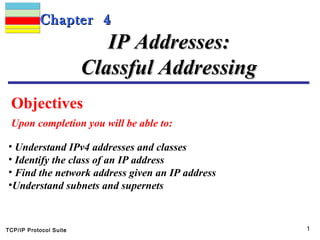This document discusses IP addressing and the TCP/IP protocol suite. It covers the following topics:
- IP addresses are 32-bit addresses that uniquely identify devices on the Internet. Early IP addressing used a system of address classes (A, B, C, etc.) that is now obsolete.
- Subnetting and supernetting were techniques used to work around the limitations of classful addressing and allow for more flexible allocation of address blocks.
- The document provides examples of converting between binary, decimal and hexadecimal IP address notations. It also covers how to determine the network address, subnet mask, and address range for given IP addresses.























































